 Events on the high street continue to grab the headlines. These are incredibly difficult times for retailers as households’ spending power continues to be squeezed and, in conjunction with technological change, households’ spending habits continue to evolve. In this blog we examine what the latest data from Consumer Trends tells us about the composition of household spending.
Events on the high street continue to grab the headlines. These are incredibly difficult times for retailers as households’ spending power continues to be squeezed and, in conjunction with technological change, households’ spending habits continue to evolve. In this blog we examine what the latest data from Consumer Trends tells us about the composition of household spending.
There are 12 broad categories of household spending. Each tells us something about the amount of expenditure in the UK by both UK and foreign households. In 2012 Q3, the value of household consumption taking place within the UK was £242 billion. During the whole of 2011, spending amounted to £929 billion. In real terms (after adjusting for price changes) spending in the UK fell by 1 per cent in 2011. Evidence of a rebound is limited. In the year to 2012 Q3, the volume of spending was just 0.8 per cent higher. In contrast, from 1998 to 2007 the average real rate of growth was 3.5 per cent.
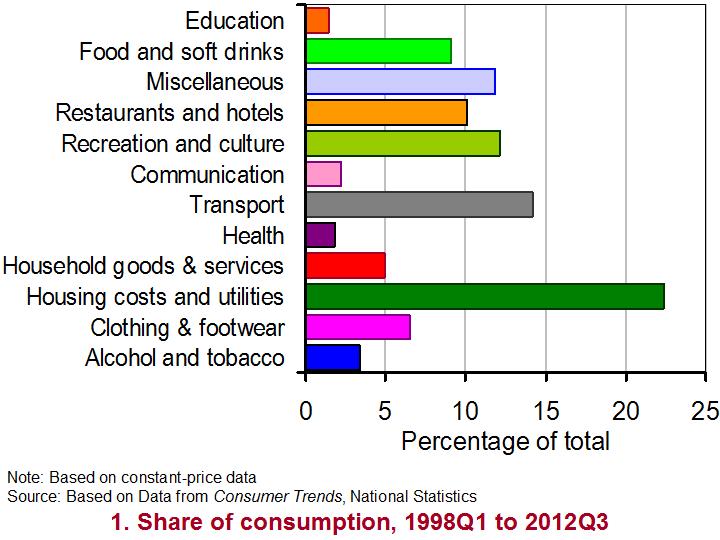 As Chart 1 shows, the largest component of household spending in the UK is on spending associated with running a home. This component includes rents, expenditures incurred in undertaking routine maintenance and the payments for electricity, gas and water. Since 1997 this component has typically accounted for (after adjusting for price changes) 24 per cent of household consumption in the UK (22 per cent in 2012 Q3). The second largest consumption category is transport. This includes expenditure on purchasing vehicles, fuels, maintenance of vehicles and the costs of rail and air transport. It has typically accounted for about 15 per cent of expenditure (14 per cent in 2012 Q3).
As Chart 1 shows, the largest component of household spending in the UK is on spending associated with running a home. This component includes rents, expenditures incurred in undertaking routine maintenance and the payments for electricity, gas and water. Since 1997 this component has typically accounted for (after adjusting for price changes) 24 per cent of household consumption in the UK (22 per cent in 2012 Q3). The second largest consumption category is transport. This includes expenditure on purchasing vehicles, fuels, maintenance of vehicles and the costs of rail and air transport. It has typically accounted for about 15 per cent of expenditure (14 per cent in 2012 Q3).
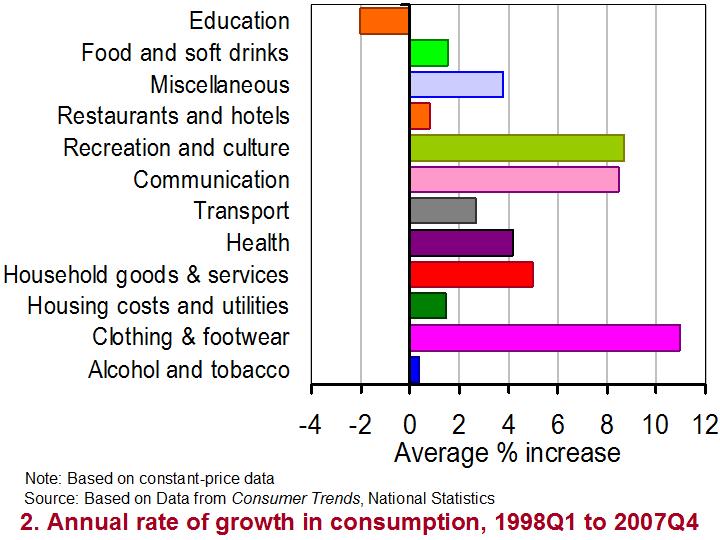 Chart 2 shows the real annual rate of growth in expenditure of our 12 consumption categories from 1998 Q1 to 2007 Q4 and so before the financial crisis really took hold. It enables us to measure how the volume of purchases changes over a 12-month period. From it, we can see that all categories, except education, contributed to the positive real growth of household spending in the UK. The fastest growing component was clothing and footwear recording real growth of almost 11 per cent per year. The second most rapidly growing component was recreation and culture, which includes items ranging from package holidays, garden plants and musical instruments to sports equipment, cameras and books. This component grew, after adjusting for inflation, by nearly 9 per cent per year.
Chart 2 shows the real annual rate of growth in expenditure of our 12 consumption categories from 1998 Q1 to 2007 Q4 and so before the financial crisis really took hold. It enables us to measure how the volume of purchases changes over a 12-month period. From it, we can see that all categories, except education, contributed to the positive real growth of household spending in the UK. The fastest growing component was clothing and footwear recording real growth of almost 11 per cent per year. The second most rapidly growing component was recreation and culture, which includes items ranging from package holidays, garden plants and musical instruments to sports equipment, cameras and books. This component grew, after adjusting for inflation, by nearly 9 per cent per year.
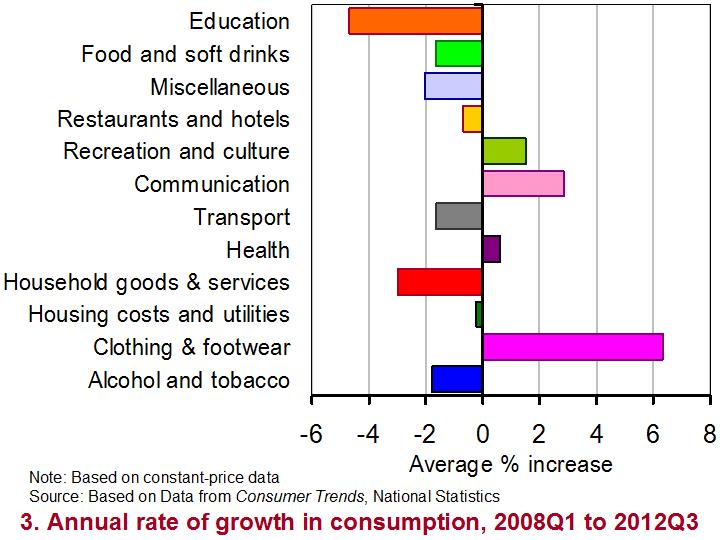 Chart 3 focuses on the real annual rate of growth since 2008 Q1. It paints a very different picture. Now only four categories have on average recorded positive annual rates of growth. Again, the volume of purchases of clothing and footwear has grown most rapidly by 6.3 per cent per year. While purchases on items associated with recreation and culture continue to grow, the annual rate of growth since 2008 is only 1.5 per cent compared with 9 per cent prior in the previous 10 years or so.
Chart 3 focuses on the real annual rate of growth since 2008 Q1. It paints a very different picture. Now only four categories have on average recorded positive annual rates of growth. Again, the volume of purchases of clothing and footwear has grown most rapidly by 6.3 per cent per year. While purchases on items associated with recreation and culture continue to grow, the annual rate of growth since 2008 is only 1.5 per cent compared with 9 per cent prior in the previous 10 years or so.
(Click here for a PowerPoint of all three charts.)
One category of spending that has been especially badly affected by events since 2008 has been household goods and services. This includes items such as furniture, major and small household appliances (including electrical appliances), carpets and tools. While the volume of purchases grew by 5 per cent per year from 1998 to 2007, since 2008 they have typically contracted at a rate of 3 per cent per year. This category helps to illustrate the difficult trading environment currently faced by many businesses in the UK.
Data
Consumer Trends, Q3 2012 Statistical Bulletin National Statistics
Consumer Trends Time Series Dataset, Q3 2012 National Statistics
Articles
Surprise UK retail sales drop fuels trip-dip recession fears The Guardian, Larry Elliott (15/2/13)
UK retail sales fall unexpectedly in January BBC News, (15/2/13)
Retail sales: What the economists say The Guardian, Phillip Inman (15/2/13)
Another dark day for the high street as John Lewis cuts jobs The Guardian, Sarah Butler (13/2/13)
Republic chains enters administration BBC News, (15/2/13)
High Street retailers: Who has been hit the hardest? BBC News, (13/2/13)
Questions
- Using Charts 2 and Chart 3 construct a short briefing paper comparing the fortunes of difficult components of consumption before and after 2008.
- What economic factors could explain the contrasting impact of the economic slowdown since 2008 on the components of consumption?
- Can economic factors alone explain the success of failure of businesses? Explain your answer drawing on real-world examples.
- What factors do you think are likely to be important for the growth in consumer spending in the months ahead?
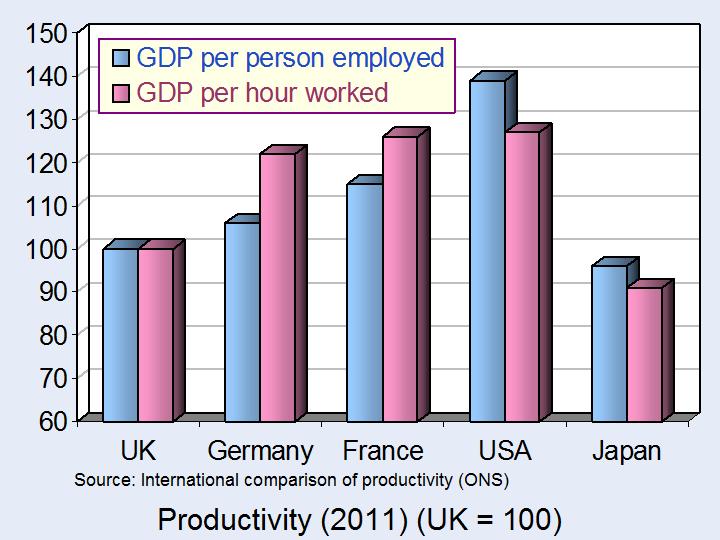 Recent figures from the ONS suggest that the UK lags well behind its competitors in terms of labour productivity. In terms of output per hour worked, Germany produces 22% more than the UK, France produces 26% more, the USA produces 27% more, the Netherlands 31% more and Ireland 43% more. The first chart illustrates some of these figures.
Recent figures from the ONS suggest that the UK lags well behind its competitors in terms of labour productivity. In terms of output per hour worked, Germany produces 22% more than the UK, France produces 26% more, the USA produces 27% more, the Netherlands 31% more and Ireland 43% more. The first chart illustrates some of these figures.
(Click here for a PowerPoint of this chart.)
And in the past few years the problem has been getting worse. This is shown in the second chart. This, however, is a relatively recent phenomenon. Until 2006, the gap was narrowing, but since then it has widened. (Click here for a PowerPoint of the second chart.)
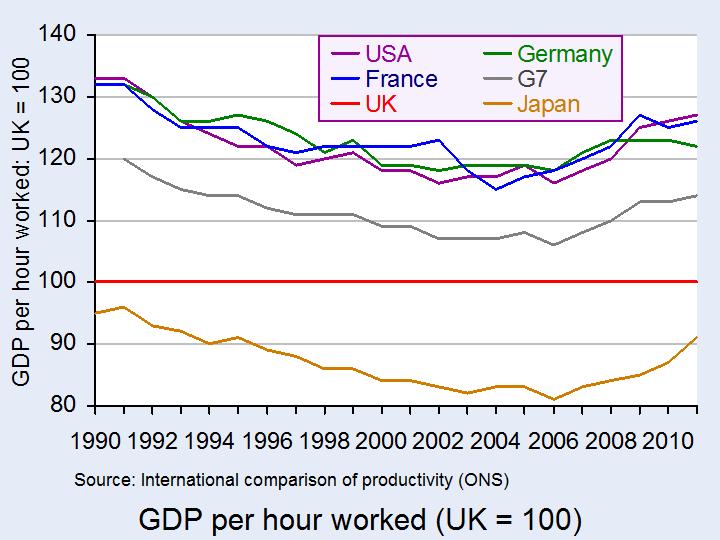 What has caused this widening of the gap? Part of the problem is a historical lack of investment in the UK. Between 2005 and 2012, the UK invested on average 15.7% of GDP. The USA invested 16.5%, Germany 17.9% and France 20.1%. And part of the problem has been the cut back in private-sector investment in response to the recession (which has been deeper in the UK) and in public-sector investment as part of the government’s austerity measures.
What has caused this widening of the gap? Part of the problem is a historical lack of investment in the UK. Between 2005 and 2012, the UK invested on average 15.7% of GDP. The USA invested 16.5%, Germany 17.9% and France 20.1%. And part of the problem has been the cut back in private-sector investment in response to the recession (which has been deeper in the UK) and in public-sector investment as part of the government’s austerity measures.
Part of the problem has been lower levels of inward investment. Inward direct investment to the UK in 2011 was only 24 per cent of that in 2007. In France, Germany, Italy and the USA, the figures were 43, 50, 66 and 105 per cent respectively.
Part of the problem has been the size of the financial sector in the UK. This is considerably larger as a proportion of the economy than in most the UK’s major competitors. And it was this sector most hard hit by the crisis of 2007/8.
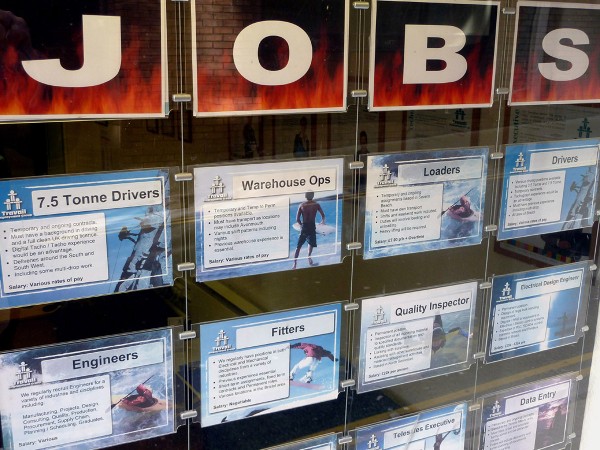 With this poor productivity performance, you might expect unemployment to have soared. In fact, the UK has one of the lowest unemployment rates of the developed countries and in recent months it has been falling while other countries have seen their unemployment rates rise.
With this poor productivity performance, you might expect unemployment to have soared. In fact, the UK has one of the lowest unemployment rates of the developed countries and in recent months it has been falling while other countries have seen their unemployment rates rise.
In fact, low productivity and high employment are compatible. If people produce less than their counterparts abroad, then more people will be needed to produce the same level of output. The problem, of course, is that this only works if wages are kept down. Indeed, wages have fallen in real terms and now stand at the level of 10 years ago.
The problem of falling real wages is that this translates into a lack of demand – especially when people are trying to reduce their debts. Not only does this result in a lack of economic growth, it discourages firms from investing – and investment is one of the prime drivers of future productivity growth!
The following articles explore the problem of low productivity and its relationship with employment and with both short-term and long-term economic growth.
Articles
UK has widest productivity gap since 1993 City A.M., Ben Southwood (14/2/13)
Productivity ‘key to UK’s economic future’ SnowdropKCS (7/2/13)
Low wages and lack of investment – why UK’s productivity has slumped Wales Online, David Williamson (2/3/13)
Recovery in jobs gives a fillip before the news on growth Independent, Russell Lynch (23/1/13)
U.K. Triple-Dipping as Productivity Falls Slate, Matthew Yglesias (25/1/13)
UK productivity puzzle baffles economists BBC News, By Andrew Walker (18/10/12)
 Is low productivity a structural problem in the UK? BBC Today Programme, Bridget Rosewell and Andrew Sentance (4/1/13)
Is low productivity a structural problem in the UK? BBC Today Programme, Bridget Rosewell and Andrew Sentance (4/1/13)
We Need to Talk About the Middle Huffington Post, Stewart Wood (14/2/13)
UK Wages Slump to Lowest Level in a Decade – ONS International Business Times, Shane Croucher (13/2/13)
Britain’s low-wage economy serves as a bind on the country The Guardian, Philip Inman (13/2/13)
Real wages fall back to 2003 levels in UK The Guardian, Hilary Osborne (13/2/13)
Data
International Comparisons of Productivity – Final Estimates for 2011 ONS (13/2/13)
International Comparisons of Productivity, datasets ONS (13/2/13)
Changes in real earnings in the UK and London, 2002 to 2012 ONS (13/2/13)
Questions
- Which is a better measure of productivity – output per worker or output per hour worked? Why, do you think, does the USA produce 39% more per worker, but only 27% more per hour worked?
- What policies should the government adopt in order to encourage a growth in productivity?
- If productivity growth increased, what would be the likely effect on employment? Explain.
- Why has unemployment not risen in recent months?
 Few people have £18bn worth of funds to spend. But someone that does is Warren Buffett and a Brazilian firm, who look set to purchase Heinz for this sum. Heinz, known for things like baked beans and ketchup already has an exceptionally strong brand and is cash rich – these are two ingredients which Warren Buffett likes and have undoubtedly played their part in securing what looks to be a tasty deal.
Few people have £18bn worth of funds to spend. But someone that does is Warren Buffett and a Brazilian firm, who look set to purchase Heinz for this sum. Heinz, known for things like baked beans and ketchup already has an exceptionally strong brand and is cash rich – these are two ingredients which Warren Buffett likes and have undoubtedly played their part in securing what looks to be a tasty deal.
The company’s Board has already approved the deal, but shareholders still need to have their say and have been offered $72.50 per share. 650 million bottles of Heinz ketchup are sold every year and its baked beans, at the least in the UK, are second to none. Products like this have given Heinz its global brand name and have provided the opportunity to shareholders to make significant gains. Its Chairman said:
The Heinz brand is one of the most respected brands in the global food industry and this historic transaction provides tremendous value to Heinz shareolders.
This statement was certainly reciprocated by Warren Buffett when he spoke to CNBC, saying:
It is our kind of company … I’ve sampled it many times … Anytime we see a deal is attractive and it’s our kind of business and we’ve got the money, I’m ready to do.
 The deal therefore looks to be profitable to both sides, but is there more to it? An investigation has already been launched by the Securities and Exchange Commission as to whether information about this purchase was leaked early and was used to make money. Insider trading occurs when someone is given information early about a merger such as the one described above. They then use this information, before it is made public, to buy up a company’s stock. It is incredibly difficult to prosecute and huge amounts of money can be made by hedge funds, amongst others. This is certainly one aspect of the deal to keep your eye on.
The deal therefore looks to be profitable to both sides, but is there more to it? An investigation has already been launched by the Securities and Exchange Commission as to whether information about this purchase was leaked early and was used to make money. Insider trading occurs when someone is given information early about a merger such as the one described above. They then use this information, before it is made public, to buy up a company’s stock. It is incredibly difficult to prosecute and huge amounts of money can be made by hedge funds, amongst others. This is certainly one aspect of the deal to keep your eye on.
So, what does the future hold for Warren Buffett and Heinz? Buffett likes to extract extra value from companies he purchases and has in the past split up his businesses to create separate trading companies. However, given his taste for ketchup and his appreciation for strong global brands, it’s unlikely that we’ll see a change to the recipe of any of the well-known products. The following articles consider the takeover and the case of insider trading.
 Will Buffet ‘squeeze value’ from Heinz BBC News (15/2/13)
Will Buffet ‘squeeze value’ from Heinz BBC News (15/2/13)
Heinz-Buffett deal: will anyone spill the beans on insider trading? The Guardian, Heidi Moore (15/2/13)
Heinz bought by Warren Buffett’s Berkshire Hathaway for $28bn BBC News (14/2/13)
Traders sued over Heinz share bets Independent, Nikhil Kumar (16/2/13)
Heinz deal brings it back to its roots Financial Times, Alan Rappeport, Dan McCrum and Anoushka Sakoui (14/2/13)
Beanz means Buffet: Heinz purchased in $28bn takeover The Guardian, Dominic Rush (14/2/13)
US SEC sues over Heinz option trading before buyout Reuters (15/2/13)
Warren Buffet and Brazil’s ‘Sage’ Jorge Leman strike £18bn Heinz deal The Telegraph, Richard Blackden (15/2/13)
Questions
- What type of take-over would you class this as?
- Consider the Boston matrix – in which category would you place Heinz when you think about its market share and market growth?
- Why is a company that has a global brand and that is cash rich so tempting?
- Given your answer to question 3, why have other investors not taken an interest in purchasing Heinz?
- If you were a shareholder in Heinz, what factors would you consider when deciding whether or not to vote for the takeover?
- What growth strategy has Heinz used to establish its current position in the global market place?
- What is insider trading? Explain how early information can be used to make money in the case of Heinz.
- Explain how the share price of $72.50 is set. How does the market have a role?
 Investment is crucial in all sectors of the economy. With growing demand for travel abroad, airports across the world have begun implementing investment strategies to increase capacity. Airport bosses at Heathrow are currently considering a 5 year investment plan that is expected to cost £3 billion.
Investment is crucial in all sectors of the economy. With growing demand for travel abroad, airports across the world have begun implementing investment strategies to increase capacity. Airport bosses at Heathrow are currently considering a 5 year investment plan that is expected to cost £3 billion.
Although investment is certainly needed and passengers will benefit in the long run, the cost of this investment will have to be met by someone. If these plans are approved by the airport bosses, it is likely that ticket prices will be pushed upwards to pay for it. Any increase in charges will have to receive approval by the Civil Aviation Authority (CAA). The plan at the moment would see ticket prices, via landing charges, increase by £19.33 per passenger before a further rise to £27.30. The impact on customers has already been raised as a key concern.
 If the investment plans proceed, Heathrow expects to see its passenger numbers increase by 2.6m over the next 5 years, despite the proposed price hikes. This would naturally increase revenue and this money would provide at least some of the funds to repay the cost of the investment.
If the investment plans proceed, Heathrow expects to see its passenger numbers increase by 2.6m over the next 5 years, despite the proposed price hikes. This would naturally increase revenue and this money would provide at least some of the funds to repay the cost of the investment.
The price rises have been described as ‘incredibly steep’ and there are concerns that they will penalize customers. Airlines, such as Virgin Atlantic have recognized the need for more investment, but are more focused on finding ways to provide it without the price rises.
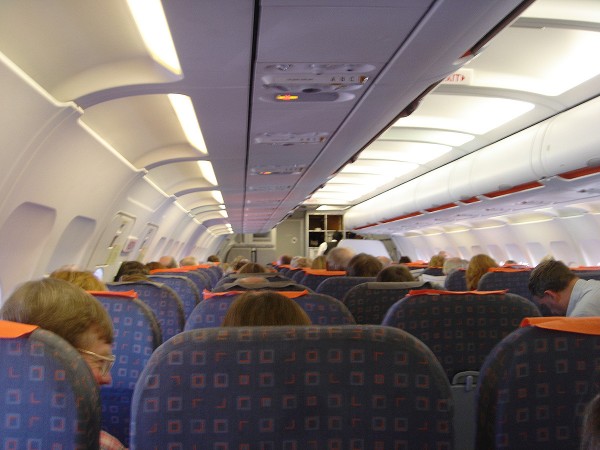 However, Colin Matthews, the Heathrow Chief said:
However, Colin Matthews, the Heathrow Chief said:
Heathrow faces stiff competition from other European hubs and we must continue to improve the service we offer passengers and airlines.
Passengers have already seen prices rise and Heathrow’s cost base has been described by British Airways as ‘inefficient’. Despite the fact that the decision by the CAA is not expected until January 2014, speculation will undoubtedly continue until any decision is reach. The following articles consider this case.
Heathrow hits turbulence over airport charges The Telegraph, Nathalie Thomas (12/2/13)
Heathrow Airport proposes ‘to raise ticket prices’ BBC News (12/2/13)
Heathrow investment to raise ticket prices Sky News (12/2/13)
Cost of Heathrow flights to rise by £27 in five years thanks to investment surcharge plans Mail Online, Helen Lawson (12/2/13)
Airlines fly into a rage as Heathrow warns charges must climb steeply Independent, Simon Calder (12/2/13)
Heathrow investment plan may lead to ticket price rise Reuters (12/2/13)
Heathrow calls for rise in airline tariffs Financial Times, Andrew Parker (12/2/13)
Questions
- If you had to undertake a cost-benefit analysis concerning the above investment proposal, which factors would you consider as the private and external benefits?
- Which factors would have to be taken into account as the private and external costs for any cost-benefit analysis?
- How important is it for the CAA to consider external costs and benefits when making its decision?
- If prices rise as the plans propose, what would you expect to be the effect on passenger numbers? How would this change be shown on a demand and supply diagram?
- According to Heathrow, they are expecting passenger numbers to increase, despite the price rises. What does this suggest about the demand curve? Illustrate your answer.
- Would you expect such an investment to have any macroeconomic impact?
 When you look at the linked articles below, I’m sure many of you will be thinking that this is an odd choice for an economics blog! However, part of the economic relevance of ‘cyber-crime fighters’ relates to the relative skills of workers and the gap that exists between the most and least skilled workers in the UK.
When you look at the linked articles below, I’m sure many of you will be thinking that this is an odd choice for an economics blog! However, part of the economic relevance of ‘cyber-crime fighters’ relates to the relative skills of workers and the gap that exists between the most and least skilled workers in the UK.
Crime has always existed, but as technology has developed the types of crime committed have grown along with the complexity of them. For certain crimes, a very skilled individual is needed. With this emergence of technologically advanced crimes, those fighting crimes have also had to improve their skills and techniques. Thus crime-fighters have become more technologically advanced as well.
The problem is that the number of skilled workers able to deal with things like cyber crime has not kept pace with the demand for them and thus we have a skills gap. Usage of the Internet has continued to grow, creating more and more opportunities for cyber crime. However, the UK supply of IT and cyber-security professionals has not been able to keep pace. Therefore, we have a shortage of skilled labour in this area.
 More investment into research and education is occurring, with the aim of addressing this shortage, but it is expected to take many years before supply catches up to demand. In particular, more investment is needed in the sciences and technology subjects at school to create the supply at university level. The NAO said that:
More investment into research and education is occurring, with the aim of addressing this shortage, but it is expected to take many years before supply catches up to demand. In particular, more investment is needed in the sciences and technology subjects at school to create the supply at university level. The NAO said that:
‘The current pipeline of graduates and practitioners are unable to meet demand.’
A second area of relevance to economics is the cost of cyber crime. The NAO estimated that the cost is somewhere between £18bn and £27bn per annum. However, on the other side, is there a case that crime actually benefits the macroeconomy by requiring government investment. As cyber crime has grown, so has the demand for cyber-crime fighters and this has created more jobs. With more jobs comes increased spending and the benefits of the multiplier. The following articles consider cyber crime and the impact it is having.
National Audit Office warns UK needs more skilled cyber crime fighters BBC News (12/2/13)
IT staff shortages raise cyber crime risk Sky News (12/2/13)
UK planning ‘Cyber Reserve’ defence force BBC News (3/12/12)
Britain vulnerable from cyber attacks for at least 20 years The Telegraph, Tom Whitehead (12/2/13)
Britain targeted by 120,000 every DAY with cost to country thought to total £27billion Mail Online, Jack Doyle (12/2/13)
Questions
- Illustrate the demand for and supply of labour curves in the market for cyber crime fighters. How is the equilibrium wage determined?
- If there is increased investment in education, how would this affect the shape and position of the MRP curve and what impact would this have on your diagram?
- If there is a shortage of cyber crime fighters, what does that suggest about the position of the two curves? Illustrate this situation and explain why it is a problem.
- Which factors would be considered by NAO in estimating the costs of cyber crime?
- Explain why crime can pay.
- How does the macroeconomy benefit from increased crime? Illustrate this on a diagram.
- Does your answer to question 5 above suggest anything about the effectiveness of using GDP as a measure of welfare?
- How is the multiplier effect relevant?
 Events on the high street continue to grab the headlines. These are incredibly difficult times for retailers as households’ spending power continues to be squeezed and, in conjunction with technological change, households’ spending habits continue to evolve. In this blog we examine what the latest data from Consumer Trends tells us about the composition of household spending.
Events on the high street continue to grab the headlines. These are incredibly difficult times for retailers as households’ spending power continues to be squeezed and, in conjunction with technological change, households’ spending habits continue to evolve. In this blog we examine what the latest data from Consumer Trends tells us about the composition of household spending. As Chart 1 shows, the largest component of household spending in the UK is on spending associated with running a home. This component includes rents, expenditures incurred in undertaking routine maintenance and the payments for electricity, gas and water. Since 1997 this component has typically accounted for (after adjusting for price changes) 24 per cent of household consumption in the UK (22 per cent in 2012 Q3). The second largest consumption category is transport. This includes expenditure on purchasing vehicles, fuels, maintenance of vehicles and the costs of rail and air transport. It has typically accounted for about 15 per cent of expenditure (14 per cent in 2012 Q3).
As Chart 1 shows, the largest component of household spending in the UK is on spending associated with running a home. This component includes rents, expenditures incurred in undertaking routine maintenance and the payments for electricity, gas and water. Since 1997 this component has typically accounted for (after adjusting for price changes) 24 per cent of household consumption in the UK (22 per cent in 2012 Q3). The second largest consumption category is transport. This includes expenditure on purchasing vehicles, fuels, maintenance of vehicles and the costs of rail and air transport. It has typically accounted for about 15 per cent of expenditure (14 per cent in 2012 Q3). Chart 2 shows the real annual rate of growth in expenditure of our 12 consumption categories from 1998 Q1 to 2007 Q4 and so before the financial crisis really took hold. It enables us to measure how the volume of purchases changes over a 12-month period. From it, we can see that all categories, except education, contributed to the positive real growth of household spending in the UK. The fastest growing component was clothing and footwear recording real growth of almost 11 per cent per year. The second most rapidly growing component was recreation and culture, which includes items ranging from package holidays, garden plants and musical instruments to sports equipment, cameras and books. This component grew, after adjusting for inflation, by nearly 9 per cent per year.
Chart 2 shows the real annual rate of growth in expenditure of our 12 consumption categories from 1998 Q1 to 2007 Q4 and so before the financial crisis really took hold. It enables us to measure how the volume of purchases changes over a 12-month period. From it, we can see that all categories, except education, contributed to the positive real growth of household spending in the UK. The fastest growing component was clothing and footwear recording real growth of almost 11 per cent per year. The second most rapidly growing component was recreation and culture, which includes items ranging from package holidays, garden plants and musical instruments to sports equipment, cameras and books. This component grew, after adjusting for inflation, by nearly 9 per cent per year. Chart 3 focuses on the real annual rate of growth since 2008 Q1. It paints a very different picture. Now only four categories have on average recorded positive annual rates of growth. Again, the volume of purchases of clothing and footwear has grown most rapidly by 6.3 per cent per year. While purchases on items associated with recreation and culture continue to grow, the annual rate of growth since 2008 is only 1.5 per cent compared with 9 per cent prior in the previous 10 years or so.
Chart 3 focuses on the real annual rate of growth since 2008 Q1. It paints a very different picture. Now only four categories have on average recorded positive annual rates of growth. Again, the volume of purchases of clothing and footwear has grown most rapidly by 6.3 per cent per year. While purchases on items associated with recreation and culture continue to grow, the annual rate of growth since 2008 is only 1.5 per cent compared with 9 per cent prior in the previous 10 years or so.









